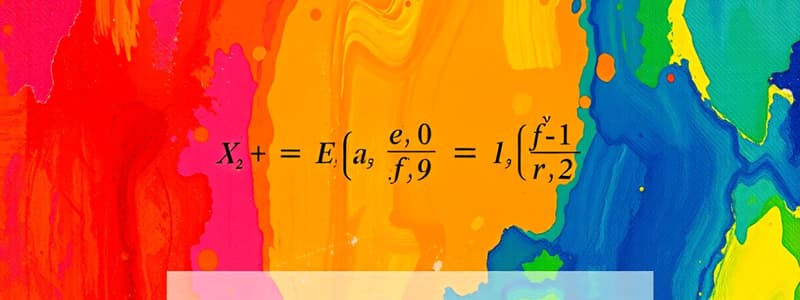Podcast
Questions and Answers
State Lambert-Beer's law. What do you mean by absorbance and transmittance?
State Lambert-Beer's law. What do you mean by absorbance and transmittance?
Lambert-Beer's law states that absorbance is directly proportional to the concentration of the absorbing species and the path length of the medium through which the light passes. Absorbance (A) measures how much light is absorbed, while transmittance (T) measures the amount of light that passes through.
What are the units used for the Molar Extinction Coefficient?
What are the units used for the Molar Extinction Coefficient?
The units for the Molar Extinction Coefficient are Molarity inverse centimeters, or $M^{-1} cm^{-1}$.
Calculate the percent transmission for a 5 cm cell filled with 0.01 M solution of $Coen,Br^{2+}$ with a molar extinction coefficient of 40 $M^{-1} cm^{-1}$ at 650 mµ. What will be the corresponding absorbance?
Calculate the percent transmission for a 5 cm cell filled with 0.01 M solution of $Coen,Br^{2+}$ with a molar extinction coefficient of 40 $M^{-1} cm^{-1}$ at 650 mµ. What will be the corresponding absorbance?
Percent transmission can be calculated using the formula: $T = 10^{- ext{A}}$, where absorbance $A = ext{ε} imes c imes l$. Given $ ext{ε} = 40 M^{-1} cm^{-1}$, $c = 0.01 M$, and $l = 5 cm$: $A = 40 imes 0.01 imes 5 = 2$. Thus, percent transmission is $T = 10^{-2} = 0.01$ or 1%. The absorbance is 2.
What concentration will be required to absorb 90% of the light for a substance in an aqueous solution at concentration of $10^{-3}$ M that absorbs 10% of incident light in a path length of 1 cm?
What concentration will be required to absorb 90% of the light for a substance in an aqueous solution at concentration of $10^{-3}$ M that absorbs 10% of incident light in a path length of 1 cm?
What is the transmittance at the same wavelength of a blue filter (72.7%) and a yellow filter (40.7%) in combination?
What is the transmittance at the same wavelength of a blue filter (72.7%) and a yellow filter (40.7%) in combination?
Calculate the molar extinction coefficient and the percent absorption for a 0.01 M solution of $[Co(NH_3)_6]^{3+}$ given that a 0.003 M solution transmits 75% of incident light of 500 mµ if the path length is 1 cm.
Calculate the molar extinction coefficient and the percent absorption for a 0.01 M solution of $[Co(NH_3)_6]^{3+}$ given that a 0.003 M solution transmits 75% of incident light of 500 mµ if the path length is 1 cm.
What is the concentration of the unknown solution (Z) based on the absorbance data from a series of standard copper solutions?
What is the concentration of the unknown solution (Z) based on the absorbance data from a series of standard copper solutions?
Flashcards are hidden until you start studying
Study Notes
Lambert-Beer's Law
- States the linear relationship between absorbance (A) and concentration (C) of a solution: A = ε * C * l, where ε is the molar extinction coefficient and l is the path length.
- Absorbance is a measure of the amount of light absorbed by a solution.
- Transmittance (T) is the fraction of incident light that passes through a solution, defined as T = I₀/I, where I₀ is the incident light intensity and I is the transmitted light intensity.
Molar Extinction Coefficient
- Units are typically expressed as M⁻¹ cm⁻¹, indicating the amount of light absorbed per molarity per centimeter of path length.
Percent Transmission Calculation
- Molar extinction coefficient of $Coen,Br^{2+}$ is 40 M⁻¹ cm⁻¹ at a wavelength of 650 nm.
- For a 5 cm path length and a 0.01 M solution, calculate absorbance (A) using A = ε * C * l.
- Corresponding percent transmission can be found with T = 10^(-A).
Concentration and Absorption
- At 10⁻³ M concentration, 10% of incident light is absorbed.
- To absorb 90% of incident light, the new concentration can be calculated based on the linear relationship from Lambert-Beer's Law.
Combined Transmittance of Filters
- A blue filter transmits 72.7% and a yellow filter transmits 40.7% at 460 nm.
- The combined transmittance is found by multiplying the individual transmittance values: T_combined = T_blue * T_yellow.
Molar Extinction Coefficient and Percent Absorption
- A 0.003 M solution of $[Co(NH_3)_6]^{3+}$ transmits 75% of incident light.
- Calculate molar extinction coefficient using the formula A = -log(T).
- Percent absorption can be calculated as Absorption% = 100% - Transmittance%.
Absorbance Data Plotting
- A series of five standard copper solutions with corresponding absorbances are provided.
- Plotting absorbance (A) against concentration (C in ppm) can help determine the concentration of the unknown sample based on the linear relationship observed.
Studying That Suits You
Use AI to generate personalized quizzes and flashcards to suit your learning preferences.




